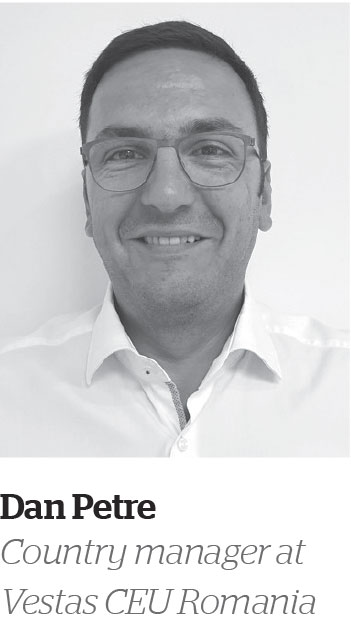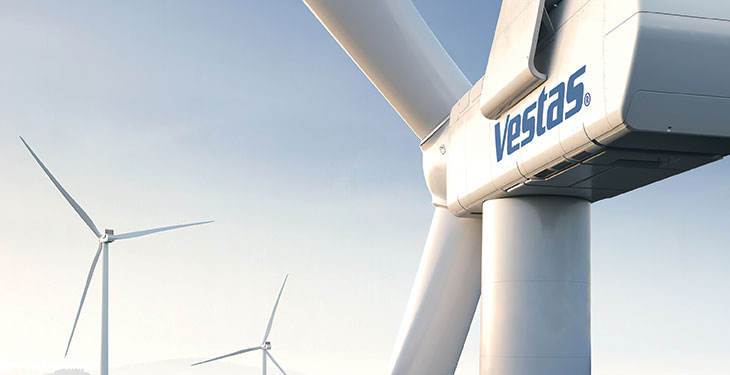After many years of stalling, wind power generation has new prospects in Romania. The liberalization of the electricity market and the introduction of PPA contracts are two encouraging elements. For the medium term, the interest shown by the riparian countries in the offshore wind potential of the Black Sea is yet another one. We talked to Dan Petre, country manager at Vestas CEU Romania, about the opportunities and challenges faced by that a large supplier of equipment and maintenance services.
Not considering 2020, we have noticed an increase in turnover and the number of employees in 2018 and 2019. On what is based this positive development and how have things been in 2020?

Also, since 2018 we had in Kogălniceanu, Constanta county, a regional warehouse with a to- tal surface of almost 2000 sqm, which is delivering parts and materials not only to the 4 local service centers, but also to the entire Eastern Europe region. Last but not least, we have in Romania the Global Hub of travelling technicians, which are travelling all around the globe to perform special tasks for other Vestas entities.
The wind farms fleet is already mature in Romania and requires more attention from a maintenance perspective. How much do the maintenance services represent in the turnover of Vestas in Romania?
Due to the fact that there has been no turbine installation activities in 2020, the turbine maintenance and all related services mentioned above represent the full turnover of Vestas in Romania. Subcontractors of Vestas from Romania with Hundreds of employees support the construction of Vestas wind turbines all over Europe.
Currently, in the context of the Green Deal and the strengthened decarbonization efforts at the European level, do you see an increased interest of investors in the Romanian wind segment?
Indeed, we notice an increased interest and we hope for a market restart very soon.
What would be the main impediments in the development of new wind farms in Romania?
The wind industry needs attractive and long term reliable political framework conditions to restart and drive the necessary expansion of wind energy in Romania based on an ambitious National Energy Plan in line with the European targets and legislation. Concrete measures and actions are needed to fulfil these plans and targets.
Hydrogen is seen by some commentators as a potential adjuvant for the intermittent production of electricity from renewable resources. Are you also aware of commercial projects in Europe? What about projects that use battery systems?
Green hydrogen is a key priority to achieve the European Green Deal and Europe’s clean energy transition. It is widely seen as a technology that can bridge the gap between electricity production from renewable energy and the goal of decarbonizing a large share of the EU’s energy consumption by 2050. In order to set the path for how hydrogen can be used in this way, and to make a first step towards setting the regulatory framework for a European hydrogen market, the EU issued its “hydrogen strategy for a climate-neutral Europe” last year.
Recently, Vestas and Mitsubishi Heavy Industries have signed an agreement to expand their partnership in sustainable energy solutions. As part of the agreement, the two companies plan to collaborate on green hydrogen. With hydrogen, we are well on the way to mastering the challenge of renewable energy storage. If you want to explore more on the status of Green Hydrogen in Europe, please, reach out to the European Clean Hydrogen Alliance website, and check also the information on our hybrid project Kennedy Park on our website.
Are there still regions in Romania with favorable wind regimes where there are no large wind farms in place?
Romania’s wind potential is the highest in Southeast Europe. There are detailed wind maps for Romania and due to the advancement of technology and the so-called low wind turbines, new or additional regions can certainly be utilized for onshore wind turbine installations.
How has Vestas technology evolved in the last 10 years since the first wave of investment in renewables?
Over the past 40 years, Vestas has continuously pioneered new technologies and solutions that have allowed us, together with our customers, to bring reliable wind energy solutions to 83 countries worldwide, thus planting the seeds of the modern wind industry. Every single project represents a journey in itself, helping us to mature the capabilities and know-how that we offer today to our business partners in order to widen wind energy’s footprint across new territories. Our latest contributions to our product portfolio are the V236-15.0 MW with the world’s largest swept area exceeding 43,000 m2, and an annual wind energy production to around 80 GWh/year which is enough to power around 20,000 European households. The V236-15MW is an offshore wind turbine though.
We also offer very powerful onshore wind turbines – and nowadays we have the right solution for every site. The Enventus platform is our highly competitive next generation onshore wind turbine. With a swept area of over 20,000m², the V162-6.0 MW™ applies the largest rotor size in the Vestas portfolio to achieve industry-leading energy production paired with a high capacity factor. Due to the large operational envelope, the V162-6.0 MW™ is relevant for low to medium wind speeds and has extensive applicability in high average wind speeds. With a standard Sound Power Level of 104dB(A) and over 25 percent higher energy production than the V150-4.2 MW™, the V162-6.0 MW™ establishes a new benchmark in competitiveness.
Romania, but also Ukraine, are interested in the offshore wind potential of the Black Sea. Are there any potential projects you see in this area?
We are following developments in the Romanian and Ukrainian renewables markets with interest. Especially, the promising prospects offered by offshore wind in this region. As a global renewables leader, Vestas strives to build scale for renewables in the future; only by doing this can we ensure a more sustainable future energy system. Offshore wind will play a crucial role in the growth of wind energy and our new V236-15.0 MW wind turbine will be a driver in this development by lowering levelized cost of energy, thus making our customers more competitive in offshore tenders going forward. As new opportunities arise, Vestas will be there.
—————————————-
This interview firstly appeared in the printed edition of Energynomics Magazine, issued in March 2021.
In order to receive the printed or electronic this issue of Energynomics Magazine, we encourage you to write us at office [at] energynomics.ro to include you in our distribution list. All previous editions are available HERE.
